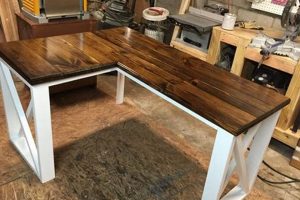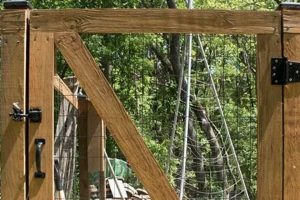The creation of sound-producing devices using readily available materials represents a diverse and accessible form of artistic expression. These homemade instruments can range from simple percussive items fashioned from recycled containers to more complex stringed or wind instruments constructed with repurposed components. A basic example includes a shaker made from a plastic bottle filled with dried beans, or a drum created using an empty bucket and a stretched piece of fabric.
This practice offers significant educational and developmental advantages, fostering creativity, problem-solving skills, and an understanding of basic acoustic principles. Historically, cultures worldwide have utilized indigenous materials to craft instruments for ceremonial, entertainment, and communication purposes, demonstrating the enduring human desire to generate music. Furthermore, the utilization of recycled materials promotes environmental consciousness and sustainable practices.
The following sections will delve into the different types of these crafted devices, explore the underlying physics of sound production involved in their operation, and provide detailed instructions for constructing several specific examples. The exploration will also cover the potential for incorporating electronic components to enhance the sounds they produce.
Construction Guidance
The following guidelines provide crucial considerations for successful instrument creation using alternative materials.
Tip 1: Material Selection: Prioritize durable and safe materials. Recycled plastics should be thoroughly cleaned, and wood should be free of splinters or sharp edges. The suitability of the chosen material significantly impacts the instrument’s longevity and playability.
Tip 2: Secure Fastenings: Employ robust adhesives and mechanical fasteners. Glue alone may not suffice for structural integrity; consider using screws, nails, or cordage to securely join components. Weak connections can lead to instrument failure and potential injury.
Tip 3: Accurate Tuning: Implement precise measuring techniques for string length or air column dimensions. Slight variations can drastically affect pitch and intonation. A chromatic tuner can assist in achieving accurate and consistent results.
Tip 4: Resonant Cavity Design: Optimize the size and shape of resonant chambers for amplified sound. Experiment with different volumes and port configurations to enhance acoustic projection. The cavity’s dimensions play a vital role in determining the instrument’s tone.
Tip 5: Surface Finish: Apply a protective coating to prevent damage and improve aesthetics. Sanding rough edges and applying varnish or paint enhances both the instrument’s appearance and its resistance to wear and tear.
Tip 6: Safety Precautions: Utilize appropriate safety equipment, such as eye protection and gloves, when cutting, drilling, or sanding materials. Working carefully minimizes the risk of injury during the construction process.
Tip 7: Experimentation and Iteration: Embrace a trial-and-error approach to refine the instrument’s design. Modifications and adjustments may be necessary to optimize its sound and playability. Continuous improvement leads to better results.
Adhering to these recommendations enhances the likelihood of crafting functional and aesthetically pleasing devices. Careful planning and execution are key to successful construction.
The subsequent sections will discuss specific instrument designs and techniques for achieving professional-quality results.
1. Material acoustic properties
The acoustic properties of materials represent a foundational element in the design and functionality of sound-producing devices. The inherent characteristics of a substance dictate its ability to vibrate, resonate, and transmit sound waves, thereby directly influencing the instrument’s tone, volume, and sustain. Within the context of creating instruments from unconventional materials, understanding these properties becomes crucial for achieving a desired sonic outcome. For instance, the density and stiffness of a material determine the speed at which sound travels through it; denser and stiffer materials generally produce higher frequencies and brighter tones. The shape of the sound vibration also varies based on the material itself, which dictates different sounds in various diy musical instruments.
The selection of materials significantly impacts the instrument’s sound quality. A drum made with a thin, flexible membrane will produce a different sound than one constructed with a thick, rigid surface. Similarly, the use of metal versus wood in the construction of a stringed instrument will result in distinct tonal qualities due to their varying densities and damping characteristics. Consider, for example, the difference between a cajn made from plywood and one constructed from solid hardwood; the hardwood version will likely exhibit a richer, more resonant tone due to its superior ability to transmit vibrations.
Therefore, careful consideration of material characteristics is essential for achieving a desired sonic output in project. The use of experimentation and iterative design principles can facilitate the discovery of unexpected and innovative sound combinations. A deep understanding of material properties, coupled with creative application, enables the creation of unique and functional sound-producing devices. As new materials and techniques emerge, the potential for sonic exploration expands, paving the way for future innovation in instrumental design.
2. Resonance chamber optimization
Resonance chamber optimization constitutes a critical aspect of crafting sound-producing devices. The dimensions, shape, and material composition of the chamber directly influence the amplification and timbre of the sound produced. Within the realm of DIY projects, careful attention to these factors can significantly enhance the acoustic properties of the finished instrument. A poorly designed chamber may result in a weak or muffled sound, while a well-optimized chamber can amplify the sound and impart a desired tonal quality. The effectiveness of a musical instrument relies on the careful consideration of the relationship between the sound source and its resonant cavity.
Several real-world examples illustrate this principle. In stringed instruments, the size and shape of the body determine the instrument’s overall volume and frequency response. Larger bodies typically produce lower frequencies, while smaller bodies tend to emphasize higher frequencies. The internal bracing patterns also play a crucial role in shaping the resonant characteristics. Similarly, in wind instruments, the length and diameter of the tube or pipe determine the pitch of the notes produced. A longer tube will produce a lower pitch, while a shorter tube will produ
ce a higher pitch. The use of different materials, such as wood or metal, will also affect the timbre of the instrument. The didgeridoo, constructed from a hollowed-out eucalyptus tree, is a example, where the length and internal diameter of the instrument dictate the fundamental pitch and harmonic overtones.
In summary, resonance chamber optimization represents a key consideration for anyone engaged in creating instruments from scratch. Understanding the relationship between chamber design and acoustic properties allows for greater control over the instrument’s sound. While challenges may arise in achieving precise measurements and optimal configurations, the effort invested in optimizing the resonance chamber yields significant improvements in the final product. A grasp of these principles enhances the likelihood of creating instruments with desired tonal characteristics and projection capabilities.
3. Tuning mechanism precision
Tuning mechanism precision is paramount in crafting functional sound-producing devices. The ability to accurately adjust and maintain the pitch of an instrument directly affects its musicality and usability. In the context of these project, where materials and construction methods may deviate significantly from those employed in mass-produced instruments, the challenge of achieving precise tuning is often amplified. A well-designed tuning mechanism allows for subtle adjustments, enabling the instrument to produce accurate notes and harmonies. Conversely, an imprecise or unstable tuning mechanism can render the instrument virtually unplayable, as it becomes impossible to maintain a consistent pitch.
Examples of this connection abound. Consider a stringed instrument fashioned from a repurposed cigar box. Without a carefully designed and precisely implemented tuning system, the strings will inevitably slip or stretch, causing the instrument to fall out of tune rapidly. Similarly, in a wind instrument constructed from PVC pipe, the placement and adjustability of tone holes are critical for achieving accurate intonation. Minor inaccuracies in hole placement can lead to significant deviations in pitch, making it difficult to play in tune with other instruments. The human voice, while not a instrument in the conventional sense, provides a relevant analogy; skilled singers possess precise control over their vocal cords, enabling them to hit notes accurately and consistently.
Ultimately, the precision of the tuning mechanism is a defining factor in determining whether a project transforms from a novelty item into a legitimate musical instrument. While achieving perfect intonation may be difficult, even with professional tools and materials, a concerted effort to create a stable and adjustable tuning system will significantly enhance the instrument’s playability and musical value. The understanding of this relationship bridges the gap between the crafting and musical expression.
4. Ergonomic playability design
Ergonomic playability design represents a critical, yet often overlooked, aspect of crafting instruments. The physical comfort and ease of use directly impact the musician’s ability to perform, regardless of the instrument’s tonal qualities. Consideration of ergonomic principles can significantly enhance the musical potential of any instrument. These principles are especially important for do-it-yourself projects, where adherence to conventional design standards may be challenging.
- Instrument Weight and Balance
The weight and distribution of mass significantly affect the player’s comfort and control. A heavy or unbalanced instrument can lead to fatigue and strain, hindering performance. Materials and construction techniques employed in DIY instruments must account for weight distribution to ensure comfortable playability. For example, a guitar crafted from dense wood without proper consideration of weight distribution may become cumbersome to hold for extended periods.
- Fingerboard and Neck Profile
The dimensions and shape of the fingerboard and neck influence the player’s hand position and finger dexterity. An improperly shaped neck can cause hand fatigue and inhibit accurate finger placement. DIY instruments often utilize unconventional materials for the neck, requiring careful shaping to ensure a comfortable and playable profile. A neck that is too thick or too thin can strain the hand, reducing performance quality and increasing the risk of injury.
- Action and String Tension
The distance between the strings and the fingerboard (action) and the tension of the strings directly affect the player’s ability to fret notes cleanly and comfortably. High action requires excessive force to press down strings, leading to finger fatigue and difficulty executing fast passages. Conversely, low action can result in buzzing and unclear notes. String tension should also be optimized to provide a balanced feel. DIY instrument builders must carefully adjust these parameters to achieve optimal playability.
- Body Shape and Contours
The shape and contours of the instrument body impact how it rests against the player’s body. Sharp edges or awkward shapes can cause discomfort and restrict movement. DIY instrument designs should incorporate ergonomic contours to conform to the player’s body, reducing pressure points and allowing for greater freedom of movement. The shape of the body must be carefully considered to balance aesthetics with ergonomic functionality.
These factors, when appropriately addressed, contribute to an enhanced musical experience. The implementation of ergonomic principles in DIY instruments not only increases player comfort but also expands the instrument’s musical potential. By integrating these concepts, craftsmen transform simple projects into tools with which to create meaningful music.
5. Durability and Longevity
The sustainability of sound-producing devices crafted outside of standardized manufacturing processes represents a significant concern. The intrinsic value of any instrument, regardless of its sonic properties or aesthetic appeal, is contingent upon its ability to withstand regular use and environmental factors over time. Therefore, when considering the creation of musical tools from alternative materials, the long-term structural integrity and resistance to degradation become paramount considerations.
- Material Selection and Treatment
The choice of constituent materials directly dictates the instrument’s resistance to physical stress, humidity, temperature fluctuations, and biological decay. Utilizing reclaimed or unconventional items often necessitates careful assessment of their inherent weaknesses and vulnerabilities. Proper sealing, coating, and reinforcement techniques are essential to mitigate potential damage and extend the lifespan. For example, untreated wood is susceptible to warping and cracking, while unprotected metals may corrode. Comprehensive material preparation is therefore a prerequisite for prolonged functionality.
- Joint Integrity and Fastening Methods
The points at which ind
ividual components are joined together represent areas of particular vulnerability. Weak or improperly executed fastenings can lead to structural failure, rendering the instrument unusable. Adhesive bonding, mechanical fasteners (screws, bolts, rivets), and interlocking designs must be carefully selected and implemented to ensure robust and reliable connections. The chosen method should be appropriate for the specific materials being joined and the anticipated stresses to which the instrument will be subjected. The longevity of a drum, for example, is determined by the adherence of drumhead and shell. - Environmental Protection and Storage
Exposure to adverse environmental conditions can accelerate the degradation of even well-constructed instruments. Proper storage practices, such as maintaining consistent humidity levels and protecting against direct sunlight, can significantly extend their functional lifespan. Cases, covers, and protective coatings provide physical barriers against dust, moisture, and accidental damage. Neglecting these precautions can lead to warping, cracking, corrosion, and other forms of deterioration, ultimately shortening the instrument’s usable life. The avoidance of such circumstances is mandatory for long-term preservation.
- Repairability and Maintenance
Even with meticulous construction and careful handling, damage or wear is inevitable over time. Designing for repairability, by using readily available replacement parts and employing reversible assembly techniques, can significantly extend the instrument’s useful life. Regular maintenance, such as cleaning, lubricating moving parts, and tightening loose connections, can also prevent minor problems from escalating into major failures. The accessibility of internal components is an important characteristic for diy musical instruments.
The considerations listed above establish a framework for maximizing the lifespan of unique musical instruments. By incorporating durability and longevity as primary design objectives, the value of these creative instruments is enhanced, guaranteeing sustainability through ongoing use.
6. Aesthetic refinement
In the realm of handcrafted sound-producing devices, visual enhancement serves as a crucial element that elevates the instruments beyond mere functionality. Aesthetic refinement, therefore, represents a thoughtful consideration of visual elements, impacting the perceived value and artistic merit of these unique musical creations. The visual appearance of a instrument, while not directly influencing its sound, enhances the overall playing experience and appreciation of the craft.
- Surface Finishing and Texturing
The application of varnishes, paints, stains, or textured coatings not only protects the instrument’s material but also significantly alters its visual appeal. A meticulously applied finish can enhance the natural grain of wood or create a visually striking, contemporary design. Examples include a smoothly polished guitar body showcasing intricate wood grain or a percussion instrument adorned with vibrant, hand-painted patterns. The use of textured surfaces can create instruments which engage on visual and tactile dimensions. Ultimately, surface treatment transforms a raw creation into an object of visual interest.
- Ornamentation and Inlay
The incorporation of decorative elements, such as inlays, carvings, and applied ornamentation, adds a layer of artistic complexity. Inlays, typically crafted from contrasting materials like mother-of-pearl or metal, can create intricate patterns on the instrument’s surface. Carvings introduce texture and depth, while applied ornamentation offers an opportunity to personalize the instrument with symbolic or representational imagery. Examples of refinement include a ukulele inlaid with geometric designs or a drum adorned with tribal carvings. Ornamentation serves to transform an instrument from a functional object into a visual masterpiece.
- Form and Proportion
The overall shape and relative dimensions of the instrument contribute significantly to its aesthetic appeal. A well-proportioned instrument conveys a sense of balance and visual harmony. Attention to form can transform a simple, functional design into an elegant and visually captivating object. For example, a stringed instrument with graceful curves and balanced proportions will be more visually appealing than one with awkward or asymmetrical features. The harmonious interplay of form and proportion is essential for creating instruments that are both visually pleasing and functionally sound.
- Material Combinations and Contrasts
The strategic combination of different materials can create visually striking contrasts and enhance the instrument’s overall aesthetic. Juxtaposing materials with contrasting colors, textures, or patterns can add depth and visual interest. Examples include combining wood with metal accents or incorporating recycled materials with vibrant colors. The deliberate use of material contrasts can transform an instrument into a visually engaging work of art.
Aesthetic refinement in DIY musical instruments is more than simply adding decoration; it represents a conscious decision to enhance the instrument’s visual appeal and transform it into an object of artistic merit. Through careful attention to surface finishing, ornamentation, form, and material combinations, can elevate their instruments from utilitarian tools into visually compelling works of art.
7. Sound variation possibilities
The capacity to generate diverse sonic textures and timbres constitutes a primary motivator for the creation of self-made musical instruments. The inherent limitations of mass-produced instruments often stifle experimentation and personalization, making do-it-yourself construction an attractive avenue for sonic exploration. The following points detail how varying construction methods and component choices contribute to an expanded palette of sound.
- Material Substitution and Hybridization
The use of unconventional materials, or the blending of disparate materials within a single instrument, presents opportunities for generating unique timbral characteristics. Substituting traditional wood with alternative substances such as bamboo, plastic, or metal alters resonant frequencies and harmonic profiles. Examples include a guitar body constructed from reclaimed shipping pallets or a drum set utilizing recycled industrial containers. The hybridization of materials, such as incorporating metal resonators into a wooden stringed instrument, creates complex sonic interactions, expanding the range of available tones.
- Acoustic Modification Techniques
Alterations to the instrument’s resonant cavity, soundboard, or vibrating element can significantly impact its tonal output. Techniques such as adding internal bracing, changing the size or shape of the sound hole, or manipulating the tension of strings or drumheads allow for fine-tuning of sonic characteristics. Examples include a guitar with adjustable internal baffles to modify resonance or a drum with a variable-tension head to control pitch and timbre. These methods enable precise manipulation of sound production, allowing for the creation of highly personalized sonic profiles.
Electronic Augmentation and EffectsThe incorporation of electronic components, such as pickups, amplifiers, and effects processors, vastly expands the sonic possibilities of do-it-yourself instruments. Attaching a piezoelectric pickup to an acoustic instrument allows for amplification and signal processing, enabling the creation of distorted, modulated, or otherwise altered sounds. Integrating effects circuits, such as reverb, delay, or distortion, directly into the instrument allows for real-time manipulation of the sound. Examples include a cigar box guitar equipped with a fuzz pedal or a kalimba with a built-in delay effect.
- Extended Techniques and Preparations
Modifying the instrument to allow for unconventional playing techniques or preparing the instrument with objects inserted into or attached to its vibrating elements can produce novel and unexpected sounds. Examples include adding extra strings or sympathetic resonators to a guitar, inserting objects between the strings of a piano, or attaching bows or mallets to the vibrating elements of a percussion instrument. These techniques exploit the instrument’s inherent sonic properties in unexpected ways, resulting in a diverse range of timbres and textures.
The exploration of sound variation possibilities remains a central tenet of creating individual instruments. By strategically manipulating materials, acoustics, electronics, and playing techniques, craftsmen unlock a universe of sonic possibilities, transforming simple materials into instruments that create new and interesting sounds.
Frequently Asked Questions
The following section addresses common inquiries and misconceptions regarding the construction of sound-producing devices using alternative materials. These responses aim to provide clarity and guidance for individuals interested in pursuing instrument creation.
Question 1: Are specialized tools necessary for building these instruments?
While advanced tools can expedite certain processes, the construction of basic sound-producing devices primarily necessitates common hand tools such as saws, hammers, screwdrivers, and measuring devices. Access to power tools such as drills and sanders can improve efficiency and precision, but are not strictly required. The complexity of the project determines the tool requirements.
Question 2: What are the primary safety considerations when working with recycled materials?
Safety precautions are paramount when utilizing recycled materials. Sharp edges, splinters, and potentially hazardous substances may be present. Thorough cleaning and inspection of materials are essential. The use of appropriate personal protective equipment, including gloves, eye protection, and respiratory masks, is mandatory. Working in a well-ventilated area minimizes exposure to harmful fumes or dust.
Question 3: How does the selection of materials impact the instrument’s sound quality?
The material composition significantly influences the acoustic properties of the instrument. Density, stiffness, and internal damping characteristics determine the instrument’s tone, volume, and sustain. Denser and stiffer materials typically produce brighter tones, while more pliable materials generate warmer sounds. Experimentation with different materials is crucial for achieving desired sonic characteristics.
Question 4: Is it possible to achieve accurate tuning with repurposed materials?
Achieving precise intonation with repurposed materials presents a challenge. However, careful measurement, precise cutting, and the implementation of adjustable tuning mechanisms can facilitate accurate tuning. The use of electronic tuners can assist in achieving and maintaining the desired pitch. Patience and attention to detail are essential for successful tuning.
Question 5: What are the common challenges encountered during the creation process?
Common challenges include material sourcing, structural integrity, and achieving desired sonic characteristics. Securing suitable materials can be time-consuming, and ensuring the instrument’s durability requires careful planning and execution. Obtaining the desired tone and volume may necessitate experimentation with different designs and materials. Perseverance and a willingness to learn from mistakes are crucial for overcoming these challenges.
Question 6: What are some resources for learning more about project construction?
Numerous online resources, including websites, forums, and video tutorials, provide guidance and inspiration for aspiring instrument builders. Books on instrument making and acoustics offer in-depth knowledge of relevant principles. Local craft guilds and maker spaces often host workshops and provide access to tools and expertise.
These responses provide a foundation for navigating the complexities of building instruments. Thorough research, careful planning, and a commitment to safety are essential for successful instrument construction.
The subsequent section will explore case studies of successful instruments, showcasing innovative designs and construction techniques.
diy musical instruments
The preceding exploration has illuminated several crucial facets surrounding the construction of sound-producing devices using alternative materials. From material selection to acoustic optimization and ergonomic design, the process demands a multifaceted understanding of physics, craftsmanship, and artistic expression. The challenges inherent in creating functional instruments from unconventional resources necessitate a commitment to experimentation, precision, and problem-solving.
The continued exploration and refinement of diy musical instruments are crucial for fostering creativity, promoting resourcefulness, and expanding the sonic landscape. By embracing innovation and challenging conventional approaches to instrument design, practitioners contribute to a rich and diverse musical culture. The future of musical expression may well depend on the ingenuity and dedication of those who dare to create their own instruments.







